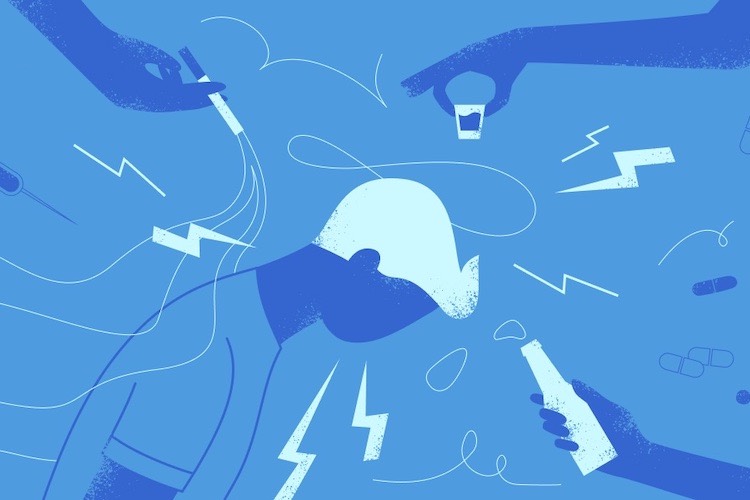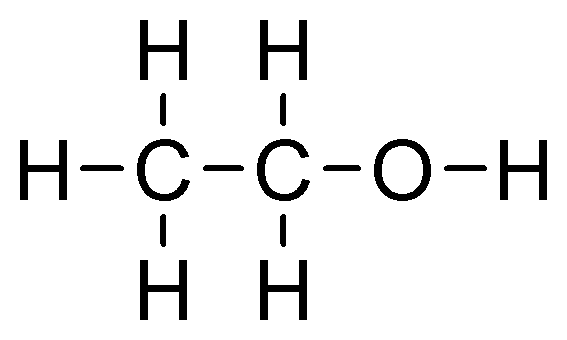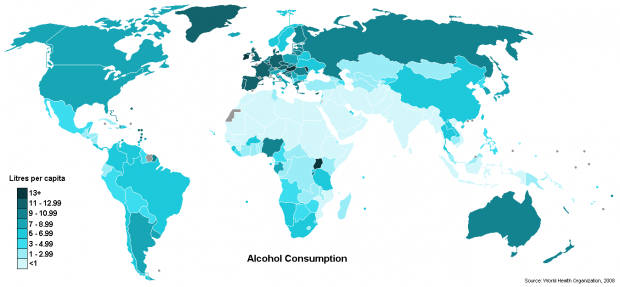Alcoholism
Neuroscientist John Krystal on alcohol’s action on the brain, social and habitual drinking, and why some people are less likely to become alcoholics than the others
faq | December 1, 2016

There are a number of different kinds of ways of thinking about how to define alcoholism. Generally speaking, we’re thinking about an array of alcohol-use disorders. At one level, you can think of alcoholism as people who are physically dependent on alcohol, which means that they drink alcohol every day, and then if they stop drinking, they will have symptoms of alcohol withdrawal, including high blood pressure, anxiety, shaking, and changes in sensory perception. Another kind of problem that people get into drinking is related to binging so that a person might not drink every day and yet still have an alcohol-use problem. They may, for example, only drink heavily on the weekends, but when they drink, they may get into trouble. They may become very aggressive. They may drive while intoxicated and get into car accidents. They may engage in risky sexual behavior that puts them at risk of HIV or other problems. They may show up for their work drunk, and they may lose their jobs. Binge drinking may also threaten their marriage or other important relationships. Lastly, people who drink heavily but not consistently may still suffer from the toxic effects of alcohol on organs like the liver. So people can have an alcohol-use disorder, a problem with drinking, even though they might not be physically dependent on alcohol.
Alcohol’s Action on the Brain
Alcohol is an incredibly simple molecule. It’s basically two carbons, a few hydrogen atoms, and then a hydroxyl group; it can hardly be simpler. And yet alcohol affects the brain in complex ways. For example, it seems to insert itself into little pockets in some of the signaling molecules in the brain, such as the receptors for chemical messengers or neurotransmitters. In this way, alcohol alters chemical communication in the brain. One of alcohol’s most potent actions is to reduce the ability of glutamate, which is the main excitatory neurotransmitter of the cortex, to signal through one of its receptors, the NMDA subtype of glutamate receptor. Interestingly, this is the same receptor that anesthetic drugs like ketamine and phencyclidine or PCP bind to. Alcohol is not an extraordinarily effective blocker of NMDA receptors, but when enough alcohol is consumed for a sufficient time period, the number of these receptors increases. When this happens, the brain becomes less sensitive and tolerant to alcohol and more sensitive to glutamate. When a heavy drinker abruptly stops drinking, you get more glutamate is released at the same it that it is more sensitive to the effects of glutamate. As a result, the brain becomes too excitable, causing the most serious and life-threatening complications of alcohol withdrawal, including seizures and delirium tremens, a form of psychosis.

Ethanol structure // wikipedia.org
Other systems in the brain also adapt to alcohol, and one of these is the GABA system. GABA is the most important inhibitory system in the cortex and the limbic system. Alcohol generally inhibits neural activity. Alcohol slips into pockets of the inhibitory GABAA receptor. When it does that, it stimulates the receptor in a way that mimics the action of certain hormones called neurosteroids. That is why alcohol is a muscle relaxant, anxiolytic, and sedative substance. At extremely high doses, alcohol can suppress breathing, which is one reason that alcohol overdoses can be life-threatening.
The brain also adapts to the overstimulation of the GABAAreceptors by alcohol by making the receptor less responsive. The way that the GABA system adapts to it is a little complicated. To simplify, an important step in the process of becoming tolerant and dependent on alcohol is that the brain switches from high-functioning GABAA receptors to lower-functioning GABAA receptors. The lower functioning GABAA receptors facilitate tolerance, in other words, the ability to drink more alcohol without feeling intoxicated. However, when one stops drinking, the lower functioning GABAA receptors cannot compensate for the loss of neural inhibition, the brain becomes more excitable, and withdrawal symptoms emerge. After about a week of sobriety, the higher functioning GABAA receptors emerge, and withdrawal symptoms abate.
Therefore, you have many changes in the brain when you drink heavily and consistently, and we have highlighted two important changes here: the excitatory glutamate system becomes more sensitive, and the inhibitory GABA system becomes less sensitive. Thus the brain becomes more excitable, and this imbalance between excitation and inhibition produces many of the symptoms that we associate with alcohol withdrawal, including anxiety, hyperarousal, increased startle, and seizures. Similarly, medications that reduce glutamate signaling or enhance GABA signalings, such as benzodiazepines, barbiturates, and anticonvulsant medications, reduce excessive brain excitability and withdrawal symptoms.
Severe Consequences
People who are physically dependent on alcohol can be at risk of severe consequences like seizures. They may, under extreme circumstances, have periods of confusion, and there is a particularly extreme form of alcohol withdrawal which is called delirium tremens, that can proceed with metabolic hyperactivity and even cause death. Most people who drink heavily are actually not at risk for those most extreme symptoms; those most extreme symptoms tend to occur in people who have several episodes of physical dependence on alcohol. Usually, people don’t have seizures until they have 5-10 episodes of heavy drinking marked by a need for detoxification or experiencing withdrawal symptoms.
As a result of other conditions, there is a variety of symptoms and problems that typically complicate alcohol-use disorders. People can develop anxiety and depression problems; people can develop seizure problems.

Treatments
The field of medicine had long recognized the medical consequences of alcoholism as appropriate for medical study, even when it considered pathological drinking to be a sign of moral weakness rather than an illness. However, as we learned more about the biological factors that interact with psychological and social factors that promote pathological drinking, the medical profession became more engaged in studying alcohol consumption and medical treatments that might reduce drinking. A turning point was the emergence of “the disease concept of alcoholism,” advanced by Professor E.M. Jellinek at Yale University in the 1940s and 1950s. In this conceptual framework, different patterns of pathological drinking were considered subtypes of a medical disorder called alcoholism. The first medical treatment for pathological drinking, disulfiram (Antabuse), was discovered in the 1920s, but it was not widely prescribed until much later. This medication, when taken every day, inhibits the enzyme aldehyde dehydrogenase, an enzyme responsible for breaking down a metabolite of alcohol called acetaldehyde. If you take disulfiram and drink, you will accumulate high levels of acetaldehyde in your body, and this will make you feel ill. Disulfiram can be very helpful in reducing drinking if you take it regularly, but many people do not benefit from it because they choose not to take it regularly. Some patients, for example, will stop taking the medication when they want to drink! However, this medication can be very effective if family members or employers supervise pill taking.
There are other medications to treat problem drinking. Naltrexone blocks the action of opioids, such as morphine, at their receptor, and some people believe that it reduces the rewarding effects of alcohol. Others suggest that it reduces heavy drinking. Acamprosate is approved for the treatment of alcoholism in the US, but its mechanism of action is not entirely clear, and it was not effective in the largest study to test this drug, the NIAAA Project COMBINE. A more recent anticonvulsant medication Topiramate, which is not yet approved for the treatment of alcoholism in the United States, also shows promise for alcoholism treatment. As noted earlier, other types of medications are used to treat alcohol withdrawal symptoms.
Heritable risk for Alcoholism
Overall, the data suggests that about 40-50% of the risk for developing alcoholism is genetic or heritable. And about 40-50% risk is environmental. Different research groups are focused on one side or the other. There has been a lot of work to identify the genetics of alcoholism. Interestingly, the biggest progress in identifying the genes related to alcoholism has been in identifying genes that are protective and that act by altering the metabolism of alcohol.
For example, a mutation in the gene that reduces the function of the enzyme aldehyde dehydrogenase is very common in people of Chinese extraction. These people are protected from developing alcoholism because their bodies metabolize alcohol as if they had taken disulfiram (the drug that inhibits this same enzyme). Another protective gene mutation occurs in the gene coding for alcohol dehydrogenase (ADH). Variants in this gene occur in some groups of European descent. In this case, increased ADH function leads to a more rapid accumulation of toxic acetaldehyde. Some people learn to overcome these deterrents and drink heavily despite these mutations, but they do so at some risk. Sustained high levels of acetaldehyde in the body may contribute to the risk of developing some forms of cancer.

Drunkenness of Noah by Giovanni Bellini, about 1515 // wikipedia.org
Other gene variants were identified, but still, there is a lot about the genetics of alcoholism that we don’t understand very well. One of the clues that we have about the risk of alcohol problems is that it seems that people who are prone to developing alcoholism have a built-in tolerance to alcohol. And it’s not just that they’re less sensitive to alcohol completely, in other words, that they experience less reward and less negative effect, but it seems that they are particularly less sensitive to the negative effects of alcohol. So when they drink alcohol, they experience the rewards as being very pleasant without having all the side effects that protect many of us from developing alcohol-use problems.
So how does that work? Well, one of the ways that it may work goes back to alcohol blockage of the NMDA glutamate receptor. In other words, when alcohol blocks the NMDA receptor, it makes us feel uncoordinated, impairs our memory, and it may contribute to the spinning feeling that some people get after drinking a lot. But it seems that people who have a family history of alcoholism have a built-in tolerance specifically to that mechanism, so they are less sensitive to drugs that block NMDA glutamate receptors, such as ketamine, and they are less sensitive to the negative effects of alcohol. Thus, it looks like a part of the heritable risk for alcoholism is mediated by mechanisms through which alcohol affects chemical signaling in the brain.
Balancing Immediate and Delayed Rewards
You might wonder if people at risk only have altered sensitivity to alcohol or if there are other things that are going on that are also inherited. And one of the interesting things that we’ve found is that people who have a similar family history of alcoholism and who have altered sensitivity to drugs like ketamine also have an interesting distortion in the way they look at the world. A big risk factor for developing addictions or problems, in general, is how you weigh opportunities for reward and punishment in your life. In other words, if people were preoccupied with the risks of drinking alcohol while they were drinking, they would drink less. For example, they might say, ‘Okay, you can have this drink, but then you’re going to lose your driving license.” But other people think I will have that drink now and worry about losing my driving license if that situation ever happens.” In other words, these people tend to devalue the delayed risks of drinking and pay attention to the immediate opportunity for reward.
The way people balance how they respond to immediate and delayed rewards and punishments is an important factor in how they make choices about how much to drink. And it turns out that people who have a family history of alcoholism are not only prone to experiencing alcohol in a more rewarding way, but they also tend to respond strongly to the immediate see of reward and not so strongly to the threat of punishments in the future. So they’re biased to respond to immediate opportunities for pleasure even though these opportunities might get them into trouble. It’s a kind of a double whammy — their body is making alcohol seem like a more attractive drug, and their motivation system biases them to respond to immediate rewards, like alcohol or drugs. In that regard, there is a lot of interest in how you can teach people to focus their attention on long-term rewards and not to be so caught up in the moment through cognitive or behavioral therapies.
Environmental and Social Factors
The environment itself is a big factor related to vulnerability to alcoholism or how inclined people are to consume alcohol. A good example here is stress. When we are under a lot of stress, the mechanisms that we rely on to manage our behavior and help us to function can sometimes get compromised. Your judgment can change, and your ability to resist certain kinds of opportunities and your ability to say ‘No’ gets compromised, and you get vulnerable to doing things that you might not do when you’re not under stress. Just like a heritable risk factor was complicated, there is also a kind of double whammy related to environmental factors.
Stress is an important contributor, however, there are some other factors related to genetics and environment, and one of them is social. Sometimes it’s easy to say ‘No’ when it’s just you by yourself at home, but if you’re at a party and you’re surrounded by people who are drinking, then there are often social pressures that are pushing people to drink.

Habitual Drinking
There is a very complicated notion in the alcohol research world we call habit. By habit, we mean that very often, people who repeatedly drink in certain situations drink somewhat automatically when they are in that situation. They do it not because alcohol makes them feel good or because they have made a specific choice to drink but because drinking behavior itself has become so routinized that the context actually evokes the behavior on its own. Very often, people will describe that they drank on an occasion when they had not intended to drink. Perhaps they were driving home and, almost without thinking, pulled into their usual bar and had a drink before they realized what they were doing. This is a very hard idea to explain and a hard idea for people to talk about because people are sometimes genuinely perplexed by their own behavior. In other words, they don’t understand how it can be that even though drinking doesn’t make them feel good, and even though they completely try to avoid drinking, sometimes they still fall into it for reasons that seem inexplicable to them. Cognitive and behavioral treatments for alcohol use disorders are specifically designed to teach people skills that can interfere with automaticity. We tell people to avoid people, places, and situations (like stress, bars, and parties) that trigger drinking. If people around them are drinking, we teach them skills that they can use to recognize their own risk and decrease their own chances of drinking.

World map showing countries by annual alcohol consumption per capita // wikipedia.org
We’ve come to understand that this transition from social drinking to habitual drinking is a biological process in the brain and that those drinking types are actually represented by neighboring but distinct circuits in the brain. You can think of it in this way: the things that we make choices to do are by their nature under our executive control and we can inhibit them better. But those behaviors which bubble up out of the primitive parts of the brain are hard to control; it’s a bit like trying to eat only one potato chip out of a bag full of chips. We want to figure out how to advance our understanding of the neurobiology of habit so that we can develop medication treatments that could promote the transition of drinking behavior from habitual to goal-orientated.
Future therapeutic directions
It’s important to identify specific risk mechanisms of alcoholism because we think that they might provide new ideas about how we may develop treatments for it. So, for example, we’ve just started a project, a five-year project, in which we’re testing the drug that might reset the body’s sensitivity to alcohol by resetting the NMDA receptor, not blocking the NMDA receptor but changing the balance of NMDA receptors on the cell membrane. It’s just one example of new approaches that people are trying to develop.
It may be possible to develop medication treatments that specifically target goal-oriented or habitual drinking. For example, an NMDA glutamate receptor-blocking drug, memantine, in many respects, does what you think a good alcohol treatment would do. If you give Memantine to people in the laboratory, it blocks some of the rewarding effects of alcohol, and it reduces reported cravings. However, if you give it to habitual drinkers, it doesn’t reduce their drinking. In other words, habitual alcohol consumption isn’t controlled by this drug, which seems to work on the goal-oriented system. This is in contrast to the effects of Naltrexone. It doesn’t reduce the rewarding, stimulating effects of alcohol or reduce alcohol craving, and yet in habitual drinkers, it reduces alcohol consumption. We think it reduces drinking without even reducing the urge to drink alcohol because it seems to hit the habitual part rather than the goal-oriented part.
Understanding different kinds of ways that people drink may help us to develop new treatments in the future. It may allow us to build existing drugs into more comprehensive therapies that will deal with both the behavioral and physical aspects, helping people to manage their stress, helping them to recognize their vulnerabilities, and giving them chemical protection against drinking.
Edited by Vera Vasilyeva





























